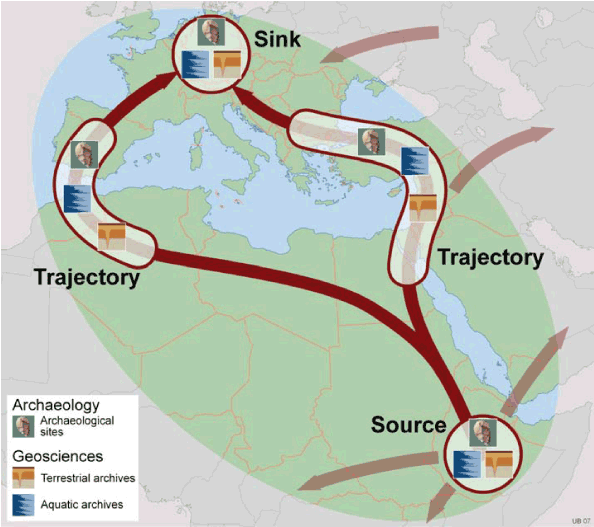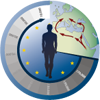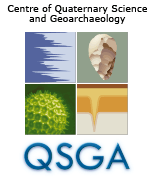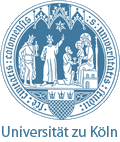Research Programme
The research strategies of the CRC correspond to the three principal themes mentioned above.
First theme:
The climatic, environmental and cultural context of the primary expansion of our species, particularly Modern Man's dispersal from Africa after 190,000 a and the occupation of Europe by 40,000 a.
All of us, all humans presently living on Earth, belong to the same species: Homo sapiens sapiens. A majority within the scientific community supports the "Out of Africa II" or “Black Eve” hypothesis assuming that Homo sapiens sapiens originated in East Africa around 190,000 years ago, and dispersed from there towards the rest of Africa, Eurasia, Australia and finally to the Americas.
Two principal findings from different disciplines have yielded evidence for the “Black Eve” theory: First, geneticists have reconstructed a family tree of Modern Man with its roots in Eastern Africa, based mainly on worldwide comparisons of the mitochondrial DNA (mtDNA) of present-day humans. Second, the earliest fossils of Homo sapiens sapiens have been found in Eastern Africa, and relatively old fossils have been found in Southern Africa and the Near East, which led physical anthropologists to support the idea of an African origin of Modern Man.
 |
| Figure 1: Our Way to Europe: Origins ("source"), corridors of diffusion ("trajectories"), periphery ("sink") and key areas selected for contextual research with special respect of the adaptive width of the human niche, given by limiting natural factors in particular regions. The human niche is considered as a product of cultural, environmental and climatic factors, thus defining the three principal disciplinary branches - corresponding to archaeological, terrestrial and aquatic archives - involved in our research strategy. |
A scientific minority holds that Modern Man evolved from several distinct regional branches of Homo erectus sensu lato into the one present species. This argument, known as the “multi-regional” hypothesis, has widely been rejected. During the last decade, however, anthropologists and archaeologists have discussed several variations of both hypotheses. New data argue the possibility of more than two events of ex-Africa dispersals, as previously accepted (Out of Africa I: Homo erectus around 1.8 million years and Out of Africa II: Homo sapiens around 190,000 years ago). Furthermore, indication of possible admixture between pre-modern (e.g. Neanderthals) and Homo sapiens sapiens populations has recently been found, though controversially debated. In Europe, the earliest Homo sapiens sapiens appear around 35,000 a BP, either as a result of direct migration over the Balkans from Africa, or from a secondary source in eastern Eurasia. Multiple directions and reverse migrations have to be taken into account, including possible reflux from the Near East to Northern Africa, which has recently been indicated by genetic investigations. While most scientists agree on the principal finding of an African origin of Modern Man and subsequent dispersal resulting in the occupation of western Eurasia and other parts of the world, the rhythms and directions of dispersal remain unclear as well as the conditions and reasons underlying the processes.
The CRC will test the eastern and western corridor of dispersal from East Africa to Europe (Figure 1) – the first is proven, the second is possible - by meso- and macro-scale reconstruction of climatic indicators and by meso- and micro-scale reconstruction of environments and cultural contexts in selected key areas. Both corridors match remarkable climatic gradients for temperature and precipitation. Consequently, the CRC will establish a chain of localities with terrestrial and aquatic archives offering the opportunity to estimate the local, regional and supra-regional environmental settings in the CRC time frame. The adjacent localities, together with comparable archives and methods, guarantee the detection of the climatic and environmental history with a temporal and spatial resolution high enough to decipher its impact on the dispersal of Modern Man to Europe.
Second theme:
Secondary occurrences of expansion and retreat of our species, induced by climatic, environmental or cultural changes, for instance the re-occupation of the Near East in the Middle Weichselian and the re-occupation of extensive parts of Europe after the end of the Last Glacial Maximum resulting in the spread and establishment of Neolithic economies throughout Europe.
Whereas the first theme examines the initial spread of Homo sapiens sapiens, the second theme deals with secondary expansion, retreat and reflux into areas which had previously been occupied, but were later abandoned and resettled. This applies for the Near East concerning the ephemeral presence of Modern Man around 90,000 and re-occupation after the first glacial maximum. In Europe, the second glacial maximum between 26,000 and 18,000 devastated large parts of the continent. After deglaciation, Europe was availible again for human re-occupation from the southern refugia. Specialised hunters immigrated to Central Europe, later adapting to broad-spectrum subsistence when the climate improved. Subsequent migration processes, interlinked with cultural diffusion, caused the transition from hunter-gatherer economies to the productive economies of the Neolithic in Europe. Each single step on the long way of diffusion, from the Near East to Central Europe, has since been subject to controversial debate about the complementary importance of migration and transfer of knowledge.
In order to describe and calculate late-glacial and postglacial migration processes, the CRC will follow a particular approach for selected regions by establishing frames of estimation of population density: When sufficient archaeological data is available, it will be the target region of possible migrations, for the time before and after the expansion.
Such population dynamics were likely influenced by climatic and environmental changes and their small-scale spatial patterns as well as by culture-environment interactions. The natural changes in the time slice of the second theme had two different characters: relatively slow Milankovitch controlled glacial/interglacial cycles contrast with short-term fluctuations such as the Dansgaard/Oeschger events during the Middle Weichselian. In order to reconstruct these centennial to millennial-scale climate fluctuations and their influence on migration processes, particularly well-dated and high-resolution archives have to be investigated. The location and north-south orientation of the CRC trajectories will contribute to a better understanding of the gradients of climate indicators, the amplitude of climate impacts originating form the North Atlantic Oscillation (NAO) in the north and the North African monsoon system in the south, as well as potential leads and lags of their teleconnections. Accordingly, the multidisciplinary geoscientific research approach will provide new information on the driving forces of the long and short-term fluctuations and the reconstruction of atmospheric circulation patterns through time.
Third theme:
Population changes, mobility and migration in coupled cultural and environmental systems, driven by growing impact of human agency on the environment, particularly dispersal, retreat and internal mobility among sedentary prehistoric societies.
After the introduction of a producing economy, migrations as well as transfer of knowledge were still important. It is our hypothesis that during the Neolithic not all of the land was being used to its carrying capacity. The supporting and limiting factors for land use are still poorly understood. Of importance are, for instance knowledge and availability of agrotechnical means, the development of cultural centres, and the climate variability. Our knowledge of the so-called "sedentary societies" is much better than the one of hunter-gatherer societies. Therefore, we plan to develop a multifactor system to better understand forcing and response factors leading to regional migrations at different periods after the beginning of the Neolithic in Europe. Subsequently, this system can be transferred to other areas and time slices of the CRC.
The archaeological aspects of theme three build upon the implication provided by palaeoenvironmental data from selected key areas (e.g. vegetation, run-off, relief, sedimentation and erosion) and supplied by a number of geoscientific projects. Furthermore, specific geoarchaeological projects will trace the integral signals of cultural systems, as expressed in sizes and localities of settlement areas. The archaeological findings will, on the other hand, allow the estimation of the amount of human impact on the environment. This will support the interpretation of geoscientific archives, in particular the differentiation between natural and anthropogenic environmental changes.







